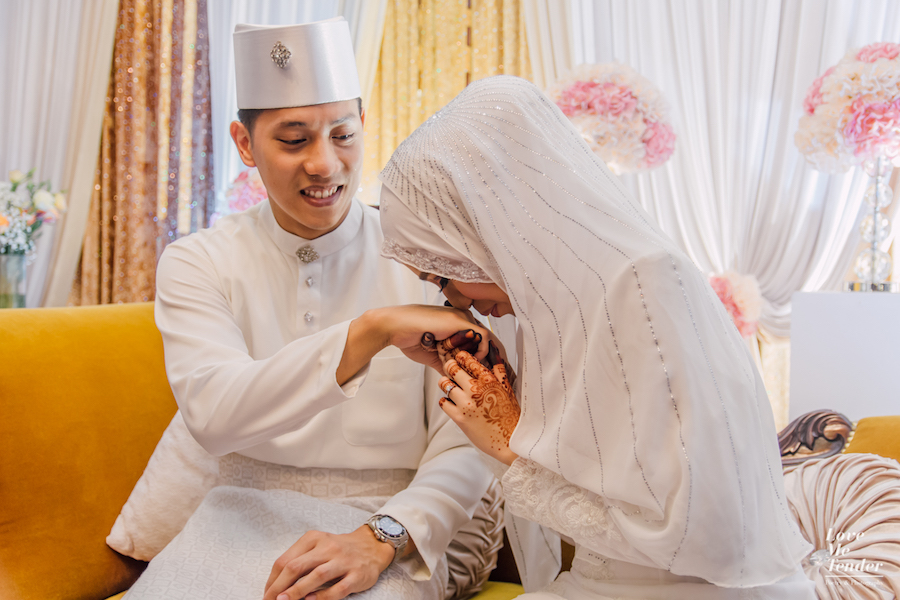All images of Sheila & Luqman’s wedding by Sirhan Hazicky, Love Me Tender Photography
“I love that you’re getting married at the place where you grew up.”
On the weekend of the 7th and 8th of January this year, when Sheila and Luqman celebrated their wedding at a void deck in Tampines, this was not a comment they expected to receive.
Unsurprisingly, it didn’t come from a Singaporean. Instead, it came from a friend named Neil, a Korean national who was born in China, has been all over the world, and speaks 6 languages. For him, ‘home’ has always been a concept, never a reality. What Sheila and Luqman treated as tradition—getting married at the void deck of Sheila’s HDB block—he saw as fortunate and meaningful.
What Neil didn’t know was that it’s common for the bride’s family’s side of the wedding celebrations to take place at her home. And neither do many Singaporeans.
When it comes to void deck weddings in Singapore, the racist, vindictive rant of one Amy Cheong remains fresh in the minds of many. Back in 2012, the then assistant director at NTUC infamously questioned how society “can let anyone get married for 50 bucks.” She was consequently fired for her remarks, but the cultural practice of void deck weddings has remained relatively unexplored in mainstream narratives.

Madam Sharifah Naraini Syed Hussein Alsagoff is 78-years old this year, and has been married for over 50 years. She tells me that void deck weddings are a remnant of a kampong* tradition.
Back in those days, in the Malay community, everyone knew everyone. As such, the entire kampong would be invited if one of its residents was getting married, and everyone would chip in to help with the cooking and setting up of decorations. While wedding attendees now give money, they used to bring food items like rice and sugar instead.
Despite being born into a rich family (her parents migrated from Arabia and lived in a house on Wareham Rd in Tanjong Katong), Madam Sharifah enjoyed these kampong festivities more than she did any hotel or restaurant wedding. Void deck weddings come close, she muses, but they’re not the same.
“What’s not the same?” I ask.
“It was a lot more playful in those days,” she says, “We would recite poems to each other, tell jokes, and so on.” She uses the word ‘muafakat’—meaning ‘compromise’—to describe the kampong spirit of where she lived for the first 12 years of her marriage after moving out of her parents’ bungalow to live with her husband. Those were the days when celebrations would start around 2 in the afternoon and last late into the night.
Today, the food and decorations at void deck weddings are more likely to be taken care of by a hired vendor rather than family and friends.
*kampongs generally refer to traditional villages, especially of indigenous peoples

All the same, practices like the kompang procession have endured. In the past, this was how the groom declared his presence at his bride’s kampong. They would loop around the ‘village’ beating their drums to announce their arrival.
This is not unlike the Chinese practice of gatecrashing, when cars honk incessantly upon the groom and groomsmen’s arrival at the bride-to-be’s home.
Yet in the imaginations of many Chinese Singaporeans, void deck weddings still stand in contrast to hotel banquet weddings, which are frequently associated with affluence. While hotels are indeed expensive, to judge a couple’s choice of venue as being merely about cost is to miss the bigger picture.
Much like how kampong weddings used to be large scale events, void deck weddings are meant to facilitate large numbers of guests. Unlike a hotel banquet where you have a space for a fixed number of people for a fixed amount of time, a void deck can be booked for a few nights, allowing the married couple to accommodate different guests on different days.
In a hotel banquet format, with fixed courses and fixed timings, this would be a nightmare.

“Logistically, it just makes sense,” says Chegu Thamrin, a wedding photographer who runs HundredPrints. “Void decks are the most accessible by public transport, and there’s always parking space. Pasir Ris for a Jurong resident might be inconvenient, but having it at a void deck, there’s no excuse not to come!”
He then goes on to explain the phenomena that many Singaporeans understand as ‘just walking into any Malay wedding and claiming to be a friend of someone’s relative.’
“Hospitality is a big part of Malay culture, and we would never turn down any curious, uninvited guest,” he says, “In some situations, if the couple is influential in the community, it’s normal for strangers to show up to pay their respects.”
He adds, “The Malay community is a closely knit one, and if possible, we would want to invite the whole kampong or estate. Also there are the little things like how, when it’s a void deck wedding, it’s a polite gesture to invite those who live on the 2nd storey right above.”
Finally, if you’re in the family tree of whoever’s getting married, that’s a ‘die die must go’ situation.

This hospitality means that 1000 pax weddings are extremely common, making void deck weddings hardly as cheap as one might assume.
“Where Amy Cheong might have gotten that idea from is because it’s $50 per day to rent the void deck space,” Luqman tells me, before Sheila proceeds to break down the rest of the numbers.
Most families rent the void deck for at least 2 days because vendors need time to set up the decorations. Because there’s no online booking system, you have to personally head to the town council, where the booking of void deck space can only be done 5 months in advance at the earliest. There’s a $300 deposit, and it costs $12 per electricity point and $8 per water point. For her wedding, these ‘utilities’ came up to a total of $64. After this, costs start to skyrocket.
The cheapest decoration package out there, Sheila says, costs $2500. But the average price is between $3000 to $5000. For her wedding, she hired a vendor who provided an all-in-one package which included food, decorations, photo services, bridal outfits, make-up, and door gifts. This set them back $21,888. And it was just for her side of the family.
That said, it’s far more common for couples to spend up to $40,000 to $50,000 for such void deck festivities. Chegu tells me that bridal outfits often cost at least $3000, and for food catering, it’s an average of $18 to $25 per head. You can do the math yourself for what 1000 guests would then cost.
At Malay weddings, the couple is considered the King and Queen for the day, and so wedding decorations often include a dais—essentially an elevated platform with a throne on which the couple sits to receive blessings and well-wishes. It’s also known as a gazebo or pelamin, and depending on how elaborate this is, it can cost up to $5000 or more.

Over the course of researching this story, I’ve learnt that there are plenty of similarities between Malay wedding culture and that of other races.
Sheila laughs about how at her side of the wedding celebrations, she knew only a quarter of the guests. Everyone else was invited by her mother, grandmother, and relatives. Luqman adds that they had a separate dinner for his side at a restaurant in Centrepoint because his parents insisted on it.
It was also because they didn’t want to deal with uninvited guests.
“It’s just easier to let your parents decide everything,” says 30-year old Shafiqah Song. “At the beginning, your parents ask you what you think of this and that, but in the end, you know they just want it a certain way. So I just let them do everything.”
“That’s a lot like Chinese weddings, where sometimes you just want something small but your parents insist on a banquet or on inviting all their colleagues or friends,” I tell her.
When I then ask if it was also her parents who picked the void deck as the venue, she says yes. Likewise, Madam Sharifah had been the one who chose the void deck for her daughter’s solemnisation ceremony. The void deck wedding, it seems, is just a cultural practice.
This feels like a relatively bland observation due to the ubiquity of Malay void deck weddings. But it’s an important distinction to make for the simple reason that many still assume that void deck weddings happen because couples can’t afford anything “better.”
More significantly, there continues to exist a clear double standard when it comes to void deck utilisation. Funerals and wakes that are held at void decks, for instance, don’t get stereotyped as being cheap arrangements for poor Chinese families.
If we can mourn a person’s passing, can we not celebrate the beginning of a couple’s new life together in equal capacity and goodwill? All these events deserve the same respectful reception, and are, ultimately, motivated by similar reasons, such as accessibility.

At the end of my conversation with Chegu, he relates an incident where a void deck wedding observed a moment of silence when a Chinese funeral procession went by the block. It was only when they were out of sight that the festivities resumed.
This, we agreed, was a vision for how this country can exist. He says, “We should be free to compare the differences (in cultural practices), yet still highly respect them.”
“That said, it’s a two way thing,” he adds as a final comment, “It’s also our responsibility to remind our non-Malay friends of the etiquette, such as how they should dress and what time they should come at for the reception. Food is free flow, but you don’t hog tables like in a banquet setting.”
He reminds me that at every Malay wedding, it is the nikah—the solemnisation—that is the most important part. Everything else, like the venue, is secondary.





